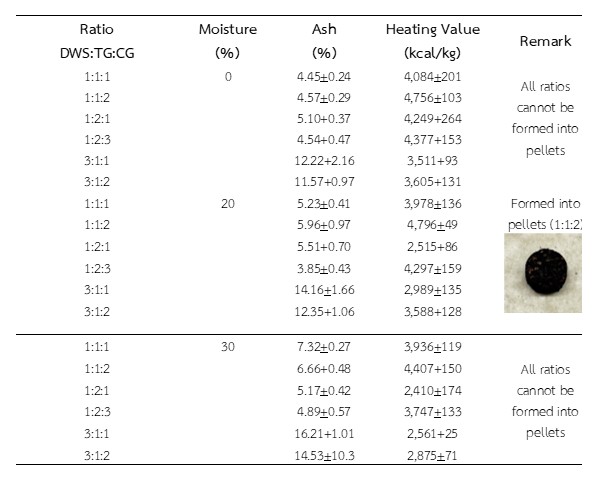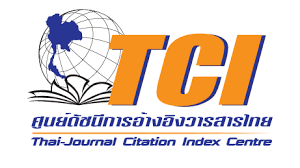Study on the Potential of Co-pelletizing Fuel from Municipal Wastewater Treatment System Sludge, Tea Ground, and Coffee Ground
Keywords:
Sludge, Tea Ground, Coffee Ground, Co-pelletizing Fuel, Renewable EnergyAbstract
Background and Objectives: To utilize sludge from wastewater treatment system and the high calorific value characteristics of tea and coffee grounds to their maximum benefits, the present research used these materials to produce co-pellet fuel. The appropriate ratio for fuel production and the characteristics of the co-pellet fuel were then investigated.
Methodology: Experiments were conducted at different ratios of municipal wastewater treatment sludge, tea ground and coffee ground of 1:1:1, 1:2:1, 2:1:1, 3:1:1, 3:1:2 and 3:2:1. The resulting samples were assessed for their fuel characteristics according to the standards set by the American Society for Testing and Materials (ASTM).
Main Results: The sludge from the wastewater treatment system was noted to be unsuitable for fuel production. On the other hand, co-pellet fuel could be produced by mixing the sludge with tea ground and coffee ground at a ratio of 1:1:2. The resulting mixture had a moisture content of 20%, an ash content of 5.96 ± 0.97% and a heating value of 4,796 ± 49 kcal/kg. Additionally, when a 1:2:3 ratio was used, the co-pellet fuel exhibited the longest combustion time, lasting 385 seconds.
Conclusions: The co-pellet fuel prepared at a ratio of municipal wastewater treatment sludge, tea ground and coffee ground of 1:1:2 could be effectively pelletized. Its ash content and heating value meet the standards outlined in the guidelines for processing waste materials into fuel pellets and briquettes established by the Department of Industrial Works. Additionally, they comply with the Industrial Product Standard for Compressed Biomass Fuel Pellets, as specified by the Thai Industrial Standard (TIS) 2772-2560.
Practical Application: Co-pellet fuel produced from the sludge of municipal wastewater treatment system in combination with tea grounds and coffee grounds can serve as an alternative energy source for households and has the potential to be transferred to industrial applications.
References
Thailand Greenhouse Gas Management Organization (Public Organization), 2018, A Guide to Calculating Greenhouse Gas Reductions for Energy and Waste Sector Projects, 240 p. (In Thai)
Humer, M. and Lechner, P., 2001, “Microbial Methane Oxidation for the Reduction of Landfill Gas Emission,” Journal of Solid Waste Technology and Management, 27 (3), pp. 146-151.
Chiemchaisri, C. and Visvanathan, C., 2008, “Greenhouse Gas Emission Potential of the Municipal Solid Waste Disposal Sites in Thailand,” Journal of the Air & Waste Management Association, 58 (5), pp. 629-635.
Thailand Greenhouse Gas Management Organization (Public Organization), 2021, Global Warming Potential (GWP) for Thailand Voluntary Emission Reduction Program (T-VER), pp. 1-3. (In Thai)
Panichayapichet, P., 2017, Reducing Greenhouse Gases from Solid Waste Management, Office of Analysis, Monitoring, and Evaluation, Thailand Greenhouse Gas Management Organization (Public Organization), pp. 1-14. (In Thai)
Tuntiwiwattanapun, N., 2019, “Coffee Grounds, from Coffee Cups to Economic Concepts Renewable Energy for Biological Products,” Environmental Journal, 23 (1), pp. 1-8. (In Thai)
Misra, M., Kondamudi N., Mohapatra, S.K. and John, S.E., 2008, “High Quality Biodiesel from Spent Coffee Grounds,” Clean Technology, 2, pp. 39-42.
Delligiannis, A., Papazafeiropoulou, A., Anastopoulos, G. and Zanikos, F., 2011, “Waste Coffee Ground as an Energy Feedstock,” Proceeding of the 3rd International Cempee and Secotox Conference, pp. 978-960.
Caetano, N. Caetano, S. and Mata, T.M., 2012, “Volarization of Coffee Grounds for Biodiesel Production,” Chemical Engineering Transactions, 26, pp. 267-272.
Battista, F., Fino, D. and Mancini, G., 2016, “Optimization of Biogas Production from Coffee Production Waste,” Bioresource Technology, 200, pp. 884-890.
Kim, J., Kim, H., Baek, G. and Lee, C., 2017, “Anaerobic Co-digestion of Spent Coffee Grounds with Different Waste Feedstocks for Biogas Production,” Waste Management, 60 (2017), pp. 322-328.
Tangmankongworakoon, N. and Preedasuriyachai, P., 2015, “A Study on How to Utilize Coffee Residue and Tea Residue for the Production of Briquettes,” Srinakharinwirot University Journal of Sciences and Technology, 7 (13), pp. 15-26. (In Thai)
Sermyagina, E., Martinez, C.L.M., Nikku, M. and Vakkilainen, E., 2021, “Spent Coffee Grounds and Tea Leaf Residues: Characterization, Evaluation of Thermal Reactivity and Recovery of High-value Compounds,” Biomass and Bioenergy, 150 (2021), pp. 1-14.
Chansongsri, T., 2014, Potential of Briquette Fuel Production using Wastewater Treatment Sludge from Cosmetic Industry, Master of Engineering Thesis, Energy and Environmental Technology Management Program, Faculty of Engineering, Thammasat University, 66 p. (In Thai)
Sangkhaphan, A., 2018, Co-pelletized Briquettes Production from Municipal Wastewater Sludge; Case Study of Pattaya Municipal Wastewater Treatment Plant, Master of Engineering Thesis, Energy and Environmental Technology Management Program, Faculty of Engineering, Thammasat University, 67 p. (In Thai)
Ersel, Y., Małgorzata, W. and Selin, A., 2018, “Co- pelletization of Sewage Sludge and Agricultural Wastes,” Journal of Environmental Management, 216, pp. 169-175.
Chua-am, S., Thongsang, S. and Yamsangsung, W., 2018, “Properties of Fuel Briquette from Corn Coband Plastic IndustrySludge,” Proceeding of the the 19th National Graduate Research Conference: NGRC, 9 March 2018, Khonkaen University, pp. 145-154. (In Thai)
Phuangchik, T., 2015, “Wood Pellets from Bamboo: Renewable Energy Enormous Value?,” Thai Science and Technology Journal, 23, pp. 35-42. (In Thai)
Chiraniramai, K. and Chooaksorn, W., 2024, “Production of the Co-pelletizing Fuel from Domestic Wastewater Sludge and Non-recyclable Waste,” Burapha Science Journal, 29 (2), pp. 481-493. (In Thai)
Chuchottaworn, J., 2013, Energy and Economic Analysis of Heat Production from Pennisetum Purpureum cv. Pakchong 1 Grass through Gassification Process, Master of Engineering Thesis, Energy Engineering Program, Graduate School, Chiang Mai University, 147 p. (In Thai)
Demirbas, A., 2007, “Effects of Moisture and Hydrogen Content on the Heating Value of Fuels,” Energy Sources, Part A: Recovery, Utilization, and Environmental Effects, 29 (7), pp. 649-655. https://doi.org/10.1080/009083190957801
Department of Alternative Energy Development and Efficiency, 2012, Report on the Project to Study the Standardization of Biomass Pellets to Develop into the Future. (In Thai)
Pukdee-asa, M. and Pimpan, P., 2022, “Fuel Briquettes from Waste of Lemon Grass and Banana Peel,” Science and Technology Nakhon Sawan Rajabhat University Journal, 14 (19), pp. 107-121. (In Thai)
Kerdwan, S., Jeendoung, R. and Getpun, S., 2019, The Production of Charcoal from Sago Bark, Research Report, Faculty of Science and Technology, Rajamangala University of Technology Srivijaya, 51 p. (In Thai)
Thassana, C. and Noolek, V., 2003, Salacca Leaf Stalk Charcoal Briquette, Final Report, Faculty of Science and Technology, Rambhai Barni Rajabhat University, 24 p. (In Thai)
Department of Industrial Works, 2012, Standards, Guidelines, and Waste Qualification Criteria for Processing into Fuel Briquette and the Interlocking Block. Bangkok: Industrial Waste Management Division, Department of Industrial Works, Ministry of Industry, 83 p. (In Thai)
Chanathaworn, J. and Phumivanichakit, K., 2019, “Effect of Coffee Silverskin and Spent Coffee Ground on Properties of Biomass Pellet Fuel,” RMUTP Research Journal, 13 (1), pp. 78-89.
Puttakarn, B., 2003, Drying Kinetics of Lychee, Master of Engineering Thesis, Energy Engineering Program, Graduate School, Chiang Mai University, 159 p. (In Thai)
Duangjaiboon, K., Kittiwan, M. and Kaewpengkrow, P.R., 2023, “Properties Analysis of Pellets Fuel from Sewage Sludge and Biomass for Renewable Energy,” Journal of Engineering and Innovation, 16 (2), pp. 29-37. (In Thai)
Soonkum, T., 2014, Identification of Gasoline on the Arsonist’s Hands and Clothes by the Technique of Gas Chromatography-Flame Ionization Detector (GC-FID), Master of Science Thesis, Forensic Science Program, Graduate School, Silpakorn University, 97 p. (In Thai)
Gil, M.V., Oulego, P., Pevida, C., Pis, J.J. and Rubiera, F., 2010, “Mechanical Durability and Combustion Characteristics of Pellets from Biomass Blends,” Biomass Technology, 101 (22), pp. 8859-8867.
Warajanont, S. and Soponpongpipat, N., 2013, “Effect of Particle Size and Moisture Content on Cassava Root Pellet Fuel’s Qualities follow the Acceptance of Pellet Fuel Standard,” International Journal of Renewable and Sustainable Energy, 2 (2), pp. 74-79. (In Thai)

Downloads
Published
How to Cite
Issue
Section
License
Copyright (c) 2024 King Mongkut's University of Technology Thonburi

This work is licensed under a Creative Commons Attribution-NonCommercial-NoDerivatives 4.0 International License.
Any form of contents contained in an article published in Science and Engineering Connect, including text, equations, formula, tables, figures and other forms of illustrations are copyrights of King Mongkut's University of Technology Thonburi. Reproduction of these contents in any format for commercial purpose requires a prior written consent of the Editor of the Journal.




